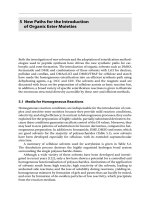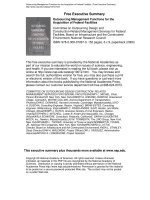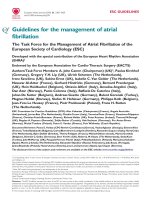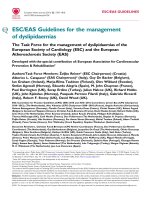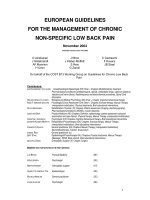Novel chiral stationary phase for the enantioseparation of racemic drugs 2
Bạn đang xem bản rút gọn của tài liệu. Xem và tải ngay bản đầy đủ của tài liệu tại đây (463.54 KB, 52 trang )
Chapter 5
Effects of Spacer Length
5.1 Introduction
In Chapter 4, we have studied the effects of substituents as chiral selectors and it
appears that phenylcarbamate CSPs are suitable for separation of a wide range of racemic
compounds. Apart from this, we understand that CSPs are usually prepared by
immobilizing chiral molecules such as modified CDs onto the silica supports via
appropriate alkyl spacers.
1-3
It appears that the type and length of the spacers in the CSPs
are also important factors in affecting the enantioselectivity in HPLC.
4-11
It was reported
that the enantioseparations of the CD CSPs are partially attributed to the spacer which
kept the cavity of the chiral molecules away from the support surface.
12
The length of the
attachment of the tether connecting the chiral selector to the chromatographic support can
have a dramatic influence in the chiral separation because the spacer makes the solutes’
access easier for the chiral discrimination to take place.
13
In this chapter, we investigate the effects of spacer length of the phenylcarbamate
CSP based on the basis of the work done in the previous chapter. In this work, three
chemically bonded ether-linkage β-CD CSPs with different spacer lengths have been
synthesized as illustrated in Figure 5.1. The three CSPs ETHE-3PC, ETHE-6PC and
ETHE-11PC (with 3-, 6- and 11-carbon spacer respectively) were derived from the
phenylcarbamoylated β-CD and immobilized onto the silica surface via a spacer arm with
different lengths. The spacer length is varied in the number of methylene group (-CH
2
-)
and the CSPs were packed into HPLC microbore column [∅ 2.1 x 150 mm] for HPLC
analysis.
107
O
OR)
7-n
( OR )
14
)(
Si
n
(
m
m = no. of carbon
Figure 5.1. CSPs with different spacer lengths.
Surface coverage for the three CSPs was calculated based on the following
formula.
6
α
exp
= (%C x 10
6
) / (1200N
c
- %C.MW) 340 [µmol/m
2
] 5-1
where α
exp
is the surface concentration, %C is the percentage of carbon of the β-
CD CSP (from elemental analysis), MW is the relative molecular mass of the chiral
ligand unit and N
c
is the number of carbon in the total chiral ligand.
Table 5.1. Elemental Analysis and Surface Concentration for the CSPs.
CSP
m
Spacer length
Elemental Analysis
Carbon (%)
α
exp,ave
*
(µmol/m
2
)
ETHE-3PC
1 3C 14.56 0.25
ETHE-6PC
4 6C 12.56 0.20
ETHE-11PC
9 11C 10.21 0.15
*The average surface coverage (α
exp,ave
) was calculated based on 3
repeat experiments.
108
From Table 5.1, it is evident that ETHE-3PC has the highest surface loading,
followed by ETHE-6PC and the lowest for ETHE-11PC. Shorter spacer arms such as
the 3- and 6-carbon spacer might contribute lesser hindrance in the immobilization
process leading to higher surface coverage. For the 11-carbon spacer, it is possible for the
long and flexible chain to possess considerable degree of flexibility and rotational
freedom that may reduce the immobilization efficiency and lead to a lower surface
coverage. The efficiency of each CSP was determined under normal phase using biphenyl
as standard. The efficiency was calculated to be ~40000 plates per meter for the three
CSP columns.
Chiral recognition abilities of the three CSPs were evaluated under normal and
reversed phase. It was found that the length of the spacer contributes significantly to the
retentivity, selectivity and resolution of the selected enantiomers. Based on the chiral
recognition trends in resolving series of chiral compounds, the dependence of the
enantioselectivity on the alkyl chain length was proposed.
5.2 Normal Phase
Substituted (1-aryl) but-3-en-1-ols are useful synthetic precursors in organic
syntheses. The alcohols were evaluated on the three CSPs under the same
chromatographic conditions for comparison purposes as summarized in Table 5.2. It
appears that the largest k’ values and highest enantioselectivity were observed on ETHE-
6PC for all the alcohols regardless of the position of substitution.
109
Table 5.2. Enantioseparations of substituted (1-aryl) but-3-en-1-ols under
normal phase.
S/n
Compound
k’
1
k’
2
α
R
s
Spacer Length
0.54 0.60 1.11 0.27
3C-
0.80 0.87 1.21 0.40
6C-
1.
OH
0.49 0.56 0.98 0.20
11C-
1.31 1.44 1.09 0.43
3C-
1.87 2.04 1.10 0.46
6C-
2.
OH
OMe
1.21 1.37 0.88 0.40
11C-
0.67 0.89 1.33 0.78
3C-
0.91 1.21 1.34 0.92
6C-
3.
OH
F
0.67 0.88 1.21 0.73
11C-
0.60 0.88 1.31 0.95
3C-
0.91 1.19 1.45 1.02
6C-
4.
OH
F
0.60 0.79 1.11 0.67
11C-
0.78 1.29 1.56 1.17
3C-
1.08 1.69 1.68 1.38
6C-
5.
OH
Cl
0.75 1.12 1.40 1.07
11C-
0.58 0.73 1.24 0.60
3C-
0.83 1.02 1.25 0.70
6C-
6.
OH
Cl
0.58 0.64 1.11 0.36
11C-
0.98 2.31 2.36 3.89
3C-
1.43 3.26 2.48 4.44
6C-
7.
OH
Br
1.04 2.48 2.07 3.75
11C-
0.87 1.29 1.47 1.83
3C-
1.34 1.98 1.48 2.10
6C-
8.
OH
Ph
0.71 0.81 1.14 0.43
11C-
0.56 0.67 1.18 0.36
3C-
0.73 0.80 1.18 0.40
6C-
9.
OH
Me
0.46 0.54 1.08 0.32
11C-
Conditions: Hexane/IPA=95/5 (v/v), flow rate at 0.1 ml/min.
110
Since most of the separated compounds showed the best chiral resolution results
on ETHE-6PC, it is believed that the optimal spacer length for solute retention and
selectivity was achieved on ETHE-6PC, which seems to be closed to 6 methylene
groups. It appears that solutes were allowed to interact more sufficiently on ETHE-6PC.
A longer spacer arm on ETHE-6PC causes the CD selector further away from the silica
surface and reduces the achiral H-bonding interaction between the solutes and the
hydroxyl groups on the silica surface. The diminished participation of achiral molecular
structures is helpful for the improvement of the enantioselectivities. In related studies
done by the Chirosep group, a pentenyl moiety was determined to be the optimal
spacer.
14
Figure 5.2 gives the plot of separation factor (α) versus spacer arm length for
the racemic samples.
0
1
2
3
# 1# 2# 3# 4# 5# 6# 7# 8# 9
Racemic Compound
Separation Factor
3C 6C 11C
Figure 5.2. Effects of spacer length on separation factor under normal phase.
111
Under normal phase, the highest enantioseparation abilities were afforded by the
6-carbon spacer CSP ETHE-6PC for selected flavanones in Table 5.3. It appears that
CSP ETHE-6PC displays greater enantioseparation abilities than the other two CSPs for
most of the test racemic compounds.
Table 5.3. Enantioseparations of selected flavanones under normal phase.
S/n
Compound
k’
1
k’
2
α
R
s
Spacer Length
1.14 1.81 1.58 2.00
3C-
1.81 2.83 1.63 2.33
6C-
1. Flavanone
O
O
2’-Hydroxyflavanone
0.77 1.02 1.32 1.50
11C-
2.56 3.58 1.40 1.41
3C-
4.21 5.98 1.42 1.48
6C-
2.
O
O
OH
1.92 2.54 1.33 1.36
11C-
3.25 3.96 1.22 1.33
3C-
5.25 6.43 1.24 1.56
6C-
3. 6-Hydroxyflavanone
O
O
OH
2.33 2.60 1.12 0.93
11C-
2.58 3.63 1.40 2.17
3C-
4.21 5.83 1.44 2.25
6C-
4. 4’-Methoxyflavanone
O
O
OMe
1.46 1.75 1.20 1.13
11C-
6.50 8.29 1.28 1.68
3C-
9.57 12.45 1.30 1.71
6C-
5. 5-Methoxyflavanone
O
O
OMe
4.18 5.31 1.27 1.70
11C-
3.92 6.33 1.62 2.10
3C-
5.83 9.94 1.70 1.76
6C-
6. 7-Methoxyflavanone
O
O
MeO
2.35 3.50 1.49 1.64
11C-
Conditions: Hexane/IPA=95/5 (v/v), flow rate at 0.1 ml/min.
112
3-Carbon spacer
α = 1.58
6-Carbon spacer
α = 1.63
11- Carbon spacer
α = 1.32
Figure 5.3. Chromatograms of flavanone on the three columns under normal
phase. Conditions: Hexane/IPA = 95/5 (v/v), flow rate at 0.1 ml/min.
The chiral recognition ability of ETHE-11PC appears to be less satisfactory and
afforded the poorest enantioseparations for all compounds in Table 5.2 and 5.3. The
rotational freedom of the long spacer arm may have contributed to its poorer interaction
with analytes. There exists a possibility that the mutual interactions between the CD
chiral selectors would lead to a possible decrease of CSP-solute interactions (Figure 5.4).
The poor solute retentivity on ETHE-11PC might also be attributed to its low surface
loading. Often, stronger retention and enantioselectivity are observed for a CSP with
higher surface loading.
113
OH
OH
Chiral Selector
Chiral Selector
Analyte
Analyte
Si
Figure 5.4. Possible mutual interactions between chiral selectors.
In summary, ETHE-6PC affords the highest solute retentivity and the best
enantioselectivity for almost all the test racemic compounds under normal phase.
Therefore, it is within reason to say the 6-carbon chain spacer appears to be the optimal
spacer length for a phenylcarbamate CSP to achieve better enantioseparation under
normal phase.
5.3 Reversed Phase
The effects of spacer length were further investigated under reversed phase (Table
5.4). The dependence of the enantioselectivity on the spacer chain length under reversed
phase was found to be similar to normal phase. In Table 5.4, ETHE-6PC affords the
strongest retention and highest selectivity factor values as expected under reversed phase.
114
Table 5.4. Enantioselectivity of test racemic compounds under reversed phase.
S/n
Compound
k’
1
k’
2
α
R
s
Spacer
Length
Condition
1.29 3.04 2.35 3.76
3C-
1
1.80 4.41 2.44 3.10
6C-
1
1. Clenbuterol
C
H
Cl
NH
2
Cl
N
H
OH
0.58 0.83 1.43 1.20
11C-
1
1.75 3.78 2.12 5.67
3C-
1
2.19 4.95 2.26 6.00
6C-
1
2. Atropine
OH
O
O
N
CH
3
Promethazine
1.04 2.04 1.96 4.00
11C-
1
5.37 10.08 1.87 4.93
3C-
1
6.26 13.07 2.08 3.05
6C-
1
3.
S
N
NMe
2
5.50 7.96 1.45 4.22
11C-
1
0.33 1.42 4.25 2.15
3C-
1
0.35 1.91 5.50 2.07
6C-
1
4. Isoproterenol
OH
OH
N
H
OH
0.10 0.30 3.00 0.67
11C-
1
9.08 13.08 1.44 3.26
3C-
1
18.13 27.69 1.53 2.69
6C-
1
5. 4’-Hydroxyflavanone
O
O
OH
6.75 8.79 1.30 1.81
11C-
1
1.58 2.42 1.53 2.80
3C-
2
2.87 4.50 1.57 2.46
6C-
2
1.17 1.50 1.29 1.05
11C-
2
6. 16.50 21.50 1.30 1.69
3C-
1
28.00 34.22 1.72 1.36
6C-
1
5-Methoxyflavanone
O
O
OMe
9.67 11.33 1.17 1.26
11C-
1
2.33 2.83 1.21 1.41
3C-
2
4.42 5.37 1.22 1.86
6C-
2
1.79 2.08 1.16 0.89
11C-
2
Condition:
1
at 1% TEAA pH 5.45/MeOH=60/40 (v/v);
2
at water/MeOH=60/40 (v/v). UV
detection at 254nm and flow rate at 0.2 ml/min.
115
0
2
4
6
# 1# 2# 3# 4# 5# 6
Racemic Compound
Separation Factor
3C 6C 11C
Figure 5.5. Effects of spacer length on separation factor under reversed phase.
It shows that the effects of spacer length are similar under normal and reversed
phase for the three CSPs. Mobile phase conditions and chiral discriminating mechanisms
have less influence on the alkyl chain length. In both phases, the 11-carbon spacer CSP
ETHE-11PC affords the poorest chiral recognition abilities. Based on the results, the 6-
carbon chain spacer on the ETHE-6PC appears to be the optimal spacer length under
normal and reversed phase.
5.4 Conclusion
The present study has demonstrated that the chromatographic performances of the
CD-based CSPs are largely influenced by spacer length; the separation factor α depends
on the spacer arm length between the silica gel and the CD molecule. In our study, it
appears that chiral separations of the three CSPs were less affected by the mobile phase
applied. Under both normal and reversed phase, there appears an optimum spacer length
of a 6-carbon chain for achieving optimal enantioselectivities. This is also demonstrated
116
by studies in the Chirosep group that a pentenyl spacer was found to be the optimal
length. At the same time, in our study, surface loading is likely to play a role in chiral
discrimination by increasing the odds of interaction between analytes and the chiral
selectors.
117
References:
1. O.A. Shpigun, I.A. Ananieva, N.Y. Budanova, E.N. Shapovalova, Russ. Chem. Rev.,
2003, 72: 1035.
2. X. H. Lai, S. C. Ng., Tetrahedron Lett., 2003, 44 (13): 2657.
3. S. C. Ng, T. T. Ong, P. Fu, J. Chromatogr. A, 2002, 968: 31.
4.
M. Kato, T. Fukushima, T. Santa, K. Nakashima, R. Nishioka, K. Imai, Analyst,
1998, 23: 2877.
5. A. Berthod, C.D. Chang, D.W. Armstrong, Talanta, 1993, 40: 1367.
6.
D. Kontrec, A. Abatangelo, V. Vinkovic, V. Sunjic, Chirality, 2001, 13: 294.
7. Z. Chen, T. Fuyumuro, K. Watabe, T. Hobo, Anal. Chim. Acta., 2004, 518: 181.
8. T. Hargitai, Y. Kaida, Y. Okamoto, J. Chromatogr., 1993, 628: 11.
9. M.H. Hyun, M.S. Na, J.S. Jin, J. Chromatogr. A, 1996, 752: 77.
10. N. Bargmann-Leyder, J. Chromatogr. A, 1994, 666: 27.
11. C. Wolf, W.H. Pirkle, J. Chromatogr. A, 1998, 799: 177.
12. K. Cabrera, D. Lubda, G. Jung, 3
rd
Int. Symp. On chiral discrimination (3’ISCD),
Poster 16, 5-8 October, Tubingen, Germany.
13. G. Felix, C. Cachau, A. Thienpont, Chromatographia, 1996, 42(9/10): 583.
14. R. Duval, H. Leveque, C. Francois, Oral Communications, 1997.
118
Chapter 6
Optimization of Enantioseparation
Conditions and Chromatographic
Properties
6.1 Introduction
Selection of an appropriate chiral CSP in HPLC analysis is crucial for
enantioseparation of racemic compounds. Each type of CSP affords unique
enantioseparation abilities based on its chiral selector, surface coverage, spacer length
etc. There is always no single CSP with universal abilities to resolve all kinds of analytes.
Enantioseparation is influenced not only by type of the CSP; it also covers a wide range
of chromatographic parameters that would help to optimize a HPLC separation. For a
particular CSP chosen, there exist many methods in resolving enantiomers with better
chromatographic results; these include selection of more suitable mobile phase, flow rate,
control of buffer pH and concentration under reversed phase and type of polar modifier
used. Investigation on these parameters was carried out to optimize the chromatographic
conditions. In addition, studies on the above-mentioned chromatographic properties can
help to provide better understanding on the roles of each parameter plays in an
enantioseparation. Furthermore, loading capacity of a particular CSP was studied to
investigate its potential in preparative scale analysis. A simple thermodynamics study
was also carried out.
Selected samples (flavanone, 5-methoxyflavanone, acebutolol and triazine) were
used to demonstrate the influence of HPLC parameters in the optimization of
chromatographic conditions on the phenylcarbamate columns, ETHE-3PC-L and
ETHE-3PC; the former was packed in a HPLC analytical column [∅ 4.6 x 250 mm] and
the latter in a microbore column [∅ 2.1 x 150 mm].
120
6.2 Mobile Phase Composition
For better resolution and selectivity, one can change the composition of the
mobile phase.
1-3
High polarity or strong eluting power solvents tend to give shorter
elution time but generally poorer resolution due to insufficient interaction of analytes
with the CSP. On the other hand, reducing the organic content in the mobile phase will
result in significant peak-tailing and broaden peaks due to long retention time. There
exists an optimal mobile phase composition for each separation under normal and
reversed phase.
4-6
6.2.1 Normal Phase
In both normal and reversed phase, solute retentivity is influenced by the
composition of the mobile phase. Table 6.1 lists the separation results of flavanone on
ETHE-3PC-L at different hexane/IPA composition under normal phase.
Table 6.1. Separation of flavanone under normal phase on ETHE- 3PC-L.
Condition
Hexane/IPA
(v/v)
Chromatographic
Results
Chromatogram
A
80/20
k’
1
= 1.17
k’
2
= 1.94
α = 1.67
R
s
= 3.50
B 70/30 k’
1
= 1.00
k’
2
= 1.55
α = 1.59
R
s
= 3.25
C 60/40 k’
1
= 0.97
k’
2
= 1.54
α = 1.52
R
s
= 2.88
Condition: UV Detection at 254 nm and flow rate at 1.0 ml/min.
121
Figure 6.1. Separation of flavanone at different hexane/IPA composition on
ETHE-3PC-L (a=separation factor). Hexane/IPA (v/v): A: 80/20; B: 70/30; C:
60/40.
We observed a slight decrease in separation factor and resolution with an increase
in IPA content in Figure 6.1. It appears that higher IPA content gives shorter solute
retention as expected.
6.2.2 Reversed Phase
Under reversed phase, buffer and organic modifier content can be altered in order
to reach an optimal separation condition for a particular sample. Enantioseparation of
acebutolol was evaluated on ETHE-3PC at different buffer composition in Table 6.2. It
shows that at higher MeOH content smaller k’ values were observed (Figure 6.2). This is
because MeOH when compared to TEAA buffer, is less polar and will tend to compete
with the analytes for the CD cavity sites. Hence, inclusion complexation of the analytes
will not be favored and analytes tend to be eluted faster.
7
This resulted in weaker
retention and faster elution of the solutes.
122
Table 6.2. Separation of acebutolol under reversed phase.
TEAA/MeOH (v/v)
k’
1
k’
2
α
R
s
A: 60/40
1.04
1.46
1.40
1.57
B: 70/30 1.96 2.71 1.38 1.89
C: 80/20 3.62 4.92 1.36 1.70
Condition: 1% TEAA pH 5.45/MeOH, flow rate at 0.2 ml/min.
Stronger solute retention does not always give higher resolution. At higher TEAA
content, the peaks were found to have poorer resolution and peak-tailing was more
significant due to mass diffusion under Condition C. Optimal resolution was observed at
Condition B. In summary, changes in mobile phase composition greatly affect the solute
retention. Changes in selectivity are less significantly observed.
Figure 6.2. Chromatograms of solute elution at Condition A, B and C for acebutolol.
123
6.3 Effects of pH under Reversed Phase
Control of pH helps to determine the degree of ionization for analytes bearing
weak acidic or basic functional groups. It can help to eliminate or increase potential H-
bonding interaction sites and change the interactions involved between analytes and the
CSP. Alteration in the amount of H-bond donors and/or acceptors often has significant
effects on chiral recognition.
6, 8-10
Neutral and ionized solutes perform differently as the
pH conditions are varied.
A lower pH value usually results in shorter retention time. It is believed that a
lower pH buffer helps to ionize the analyte, making it less hydrophobic. It can also help
to suppress the silanol activity on the column to decrease the unwanted interactions
between basic molecules with the acidic silanols. The former is important because
hydrophobicity of an analyte contributes to inclusion complexation under reversed phase.
For most of the analytes, the presence of a weakly acidic and/or basic site on a solute
requirs an optimal pH value for separation. Under different pH values, the separation will
change for a particular sample. The greatest pH effect can be observed near the pKa value
of the compound. Generally pH values accepted for CD CSPs range from 3.0 to 8.0. At
higher pH values, the silica gel would be destroyed whereas at a pH lower than 3.0,
cleavage of chiral ligands could be observed.
In Table 6.3, a shorter retention time was observed at lower pH for acebutolol.
This might due to the formation of an acetate salt upon protonation of the secondary
amine on the β-blocker (Figure 6.3).
124
Table 6.3. Separation of acebutolol on ETHE-3PC at different pH values.
pH
k’
1
k’
2
α
R
s
4.10 1.04 1.46 1.40 1.57
4.80 1.17 1.62 1.39 1.57
5.45 1.17 1.67 1.43 1.65
Condition: 1% TEAA/MeOH=60/40 and flow rate at 0.2 ml/min.
The protonated, cationic species failed to form a tight inclusion complex with the
CD cavity due to its reduced hydrophobicity. Ionization of the solute prevented H-
bonding from taking place. Hence, the analyte tends to be eluted faster due to poorer
interaction with the CSP. For acidic analytes, a low pH will suppress the ionization of the
acids and make them more apt to be retained in a reversed phase system.
O
NH
2
O
O NH
2
OH
+
+
Figure 6.3. Protonation of acebutolol at low pH.
As the pH increases, effects on retention time become less significant. Generally,
greater resolution and separation factors were observed as the pH increases as illustrated
in Figure 6.4.
125
0.9
1
1.1
1.2
4.1 4.8 5.45
pH
k'
1.2
1.4
1.6
1.8
4.1 4.8 5.45
pH
Separation Factor Resolution
Figure 6.4. Effects of pH on solute retentivity, selectivity and resolution.
6.4 Flow Rate
Flow rate of the mobile phase plays an important role on the k’ and R
s
values of a
solute. Generally larger k’ values were observed at slower flow rate. A slower flow rate
often gives better resolution because solutes are allowed to interact with the CSP
sufficiently. Control of the flow rate is therefore one of the easiest ways to optimize an
enantioseparation though resolution of peaks within shorter retention time is always
preferred. Generally the flow rate of an analytical column is between 0.1 ml/min to 2.0
ml/min depending on the dimension of the column used.
Table 6.4. Separation of 5-methoxyflavanone on ETHE-3PC at different flow rate.
Flow Rate (ml/min)
k
1
k
2
α
R
s
0.1 2.60 3.36 1.29 1.80
0.2 0.88 1.30 1.48 1.58
0.5 0.20 0.40 1.23 1.29
Condition: Water/MeOH=40/60 (v/v) and flow rate at 0.2 ml/min.
126
Separation of 5-methoxyflavanone on ETHE-3PC at different flow rates was
studied in Table 6.4. The highest selectivity was observed at a flow rate = 0.2 ml/min. k’
values were greatly affected by the flow rate as depicted in Figure 6.5. It can be clearly
seen from Figure 6.6 that a shorter retention time, sharper and closer peaks were observed
at higher flow rate; poorer resolution and broader peaks occurred at lower flow rates due
to mass diffusion.
Figure 6.5. Influence of flow rate (0.1, 0.2 and 0.5 ml/min) on the enantioseparation of
5-methoxyflavanone on ETHE-3PC (a=separation factor).
Figure 6.6. Stack view of chromatograms at different flow rate.
127
6.5 Organic Modifier under Reversed Phase
CD CSPs are usually used under reversed phase because inclusion complexation
can be easily formed in aqueous or aqueous-organic solutions
.
11-14
The inclusion constant
and binding strength of an inclusion complex decrease with the addition of a sufficient
amount of organic modifier. Two types of commonly used organic modifiers under
reversed phase HPLC are MeOH and CH
3
CN (or ACN). It was found that CH
3
CN has a
stronger displacement effect than MeOH due to its higher affinity with the CD cavity.
Because of its weaker displacement ability, MeOH is often used as the starting solvent.
Separation of acebutolol in MeOH and CH
3
CN was evaluated on ETHE-3PC in
Figure 6.7, it appears that CH
3
CN reduces retention time to a great extent and affords a
slight decrease in selectivity. Baseline resolution of acebutolol was achieved at higher
MeOH content under Conditions B and C (Table 6.5). The highest selectivity was
observed at Condition C for CH
3
CN.
0
1
2
3
4
5
6
ABCD
Capacity Factor
MeOH ACN
0
0.4
0.8
1.2
1.6
ABCD
Separation Factor
MeOH ACN
Figure 6.7. Influence of organic modifier (MeOH or CH
3
CN) on k’ and α. HPLC conditions:
Flow rate at 0.2 ml/min, UV detection at 254 nm, Mobile phase: 1% TEAA buffer pH
4.10/organic modifier (v/v): A: 60/40; B: 70/30; C: 80/20; D: 95/5.
128
Table 6.5. Separation of acebutolol at Condition B and C using
MeOH or CH
3
CN as organic modifier.
Condition
MeOH
CH
3
CN
B
k’
1
=1.96
k’
2
=2.71
α=1.38
R
s
=1.89
k’
1
=0.76
k’
2
=0.84
α=1.11
R
s
=0.43
C
k’
1
=3.62
k’
2
=4.92
α=1.36
R
s
=1.70
k’
1
=1.08
k’
2
=1.52
α=1.41
R
s
=1.65
Condition: 1% TEAA buffer pH 4.10/organic modifier (v/v):
B: 70/30; C: 80/20.
6.6 Concentration of TEAA Buffer under Reversed Phase
We observed that higher TEAA concentration usually gives shorter retention
time. It is believed that a higher TEAA concentration helps to mask residual silanol
groups and gives weaker solute retentivity.
6, 8
Table 6.6. Separation of acebutolol at different concentrations of TEAA.
TEAA Concentration (%)
k’
1
k’
2
α
R
s
2.0 1.00 1.33 1.33 1.14
1.5 1.08 1.48 1.37 1.30
0.5 1.12 1.56 1.40 1.36
Condition: TEAA buffer pH 4.10/MeOH=60/40 (v/v).
129
Faster elution of solutes was observed at higher TEAA concentration. Selectivity
of a solute separation decreases slightly as the TEAA concentration increases. Table 6.6
tabulates separation the results of acebutolol on ETHE-3PC under 40/60 (v/v)
MeOH/TEAA buffer at different concentrations. From Figure 6.8, it appears that TEAA
% has significant influence on resolution.
Figure 6.8. Effect of % TEAA (0.5, 1.5 and 2.0) on enantioselectivity for acebutolol
(a=separation factor).
6.7 Loading Capacity
Loading capacity is a critical factor in preparative HPLC separation. It can be
used to investigate a CSP’s potential for preparative scale separation. The higher the
loading capacity, the greater the potential it can be packed as a preparative column.
15
The
CSPs should have a high sample capacity, i.e. the number of enantio-differentiating
sorption sites per gram of sample should be as high as possible. A stationary phase
composed mostly of silica gel with only a few chiral elements can be rapidly overloaded.
130
